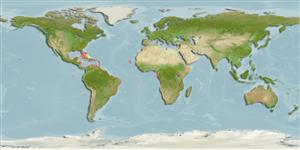>
Beloniformes (Needle fishes) >
Belonidae (Needlefishes)
Etymology: Strongylura: Greek, strongylos = round + Greek, oura = tail (Ref. 45335).
More on author: Walbaum.
Environment: milieu / climate zone / depth range / distribution range
Ökologie
seewasser; süßwasser; brackwasser riff-verbunden; tiefenbereich 1 - 3 m (Ref. 58047). Subtropical
Western Atlantic: southeastern Florida (USA), Bahamas, and northeastern Gulf of Mexico to Brazil.
Size / Gewicht / Alter
Maturity: Lm ? range ? - ? cm
Max length : 61.0 cm TL Männchen/unbestimmt; (Ref. 7251); common length : 35.0 cm TL Männchen/unbestimmt; (Ref. 5217)
Rückenflossenweichstrahlen (insgesamt): 15-17; Afterflossenweichstrahlen: 16 - 20. Caudal peduncle without a lateral keel, the least depth about equal to the width; maxilla exposed posteriorly; opercles scaled.
Adults found on reef flats, in lagoons, or in freshwater (Ref. 9710). Juveniles found among floating algae (Ref. 9710). Feeds mainly on small fishes (Ref. 3129). Oviparous (Ref. 205). Eggs may be found attached to objects in the water by tendrils on the egg's surface (Ref. 205). During the day preys on small fishes and shrimps close to water surface, approaching potential prey stealthily within lunging range, but when disturbed, may leap and skitter at the surface. At night, young individuals rest close to the surface, aligned with semi-submersed leaves of marsh grass in mangroves, and when disturbed, usually sinks slowly and hides within vegetation. The resemblance to grass blades and its night-time behavior are believed to be defensive adaptations against nocturnal visually oriented predators like night herons (Ref. 40403).
Life cycle and mating behavior
Geschlechtsreife | Fortpflanzung | Ablaichen | Eier | Fecundity | Larven
Robins, C.R. and G.C. Ray, 1986. A field guide to Atlantic coast fishes of North America. Houghton Mifflin Company, Boston, U.S.A. 354 p. (Ref. 7251)
IUCN Rote Liste Status (Ref. 130435)
Bedrohung für Menschen
Harmless
Nutzung durch Menschen
Fischereien: kleinfischerei
Mehr Information
NamenSynonymeMetabolismusRäuberÖkotoxikologieFortpflanzungGeschlechtsreifeAblaichenSpawning aggregationFecundityEierEientwicklung
ReferenzenAquakulturAquakultur ProfilZuchtlinienGenetikElectrophoresesVererbbarkeitKrankheitenVerarbeitungNutrientsMass conversion
PartnerBilderStamps, Coins Misc.LauteCiguateraGeschwindigkeitSchwimmstilKiemenoberflächeOtolithsGehirngrößeSehfähigkeit
Tools
Zusatzinformationen
Download XML
Internet Quellen
Estimates based on models
Preferred temperature (Ref.
123201): 24 - 28.1, mean 27.4 °C (based on 778 cells).
Phylogenetic diversity index (Ref.
82804): PD
50 = 0.5001 [Uniqueness, from 0.5 = low to 2.0 = high].
Bayesian length-weight: a=0.00162 (0.00104 - 0.00254), b=3.10 (2.97 - 3.23), in cm total length, based on LWR estimates for this species & Genus-body shape (Ref.
93245).
Trophic level (Ref.
69278): 4.5 ±0.8 se; based on diet studies.
Widerstandsfähigkeit (Ref.
120179): hoch, Verdopplung der Population dauert weniger als 15 Monate. (Preliminary K or Fecundity.).
Fishing Vulnerability (Ref.
59153): Moderate vulnerability (44 of 100).
Nutrients (Ref.
124155): Calcium = 49.4 [13.5, 197.1] mg/100g; Iron = 0.524 [0.222, 1.285] mg/100g; Protein = 18.3 [16.3, 20.4] %; Omega3 = 0.18 [0.07, 0.52] g/100g; Selenium = 9.41 [3.63, 24.67] μg/100g; VitaminA = 95.1 [23.1, 447.0] μg/100g; Zinc = 0.693 [0.394, 1.211] mg/100g (wet weight);
